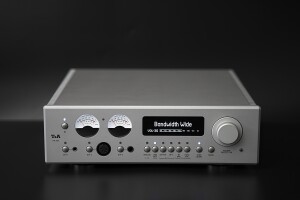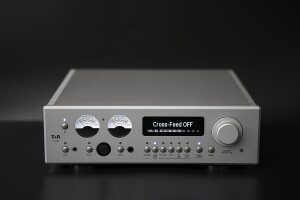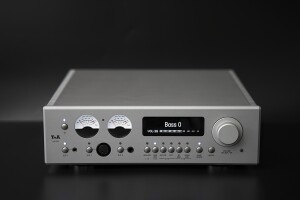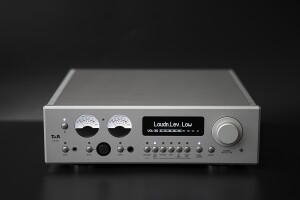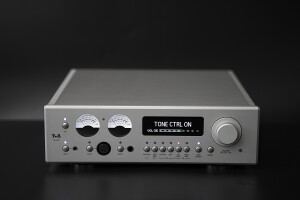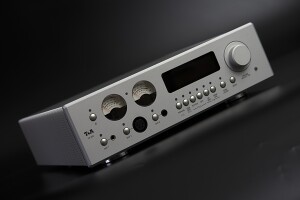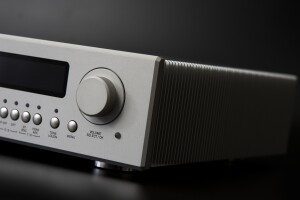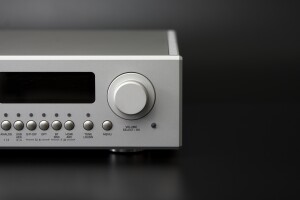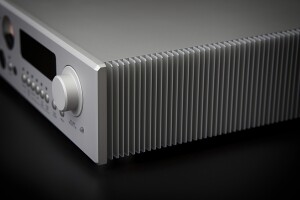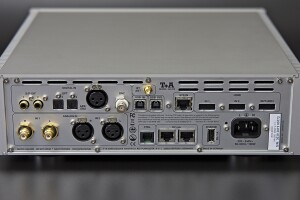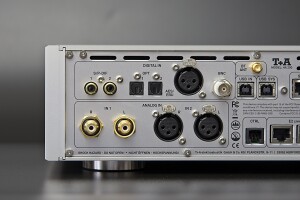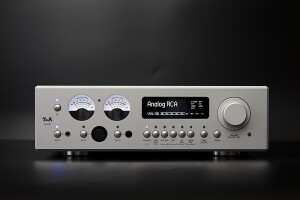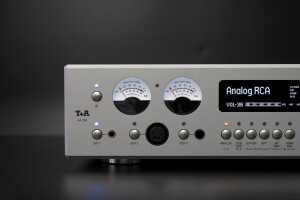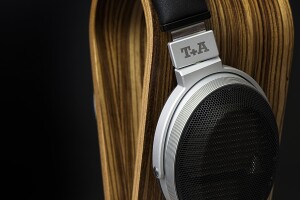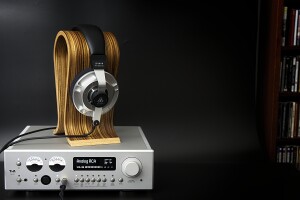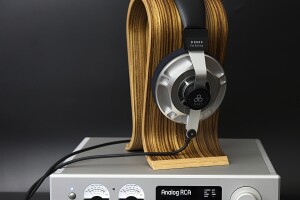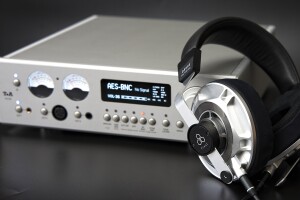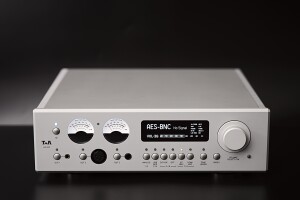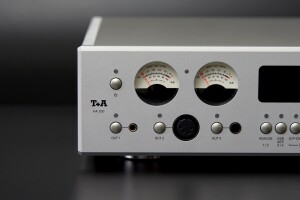It is a rare case but it does happen from time to time that a renowned audio brand surprises us by launching a product or products that go beyond the range offered so far. Last year it was the German company T+A Elektroakustik that surprised its fans by releasing their first planar-magnetic headphones, the Solitaire P and a headphone amplifier and DAC in one, the T+A HA200. We got the latter for a review.
Introduction
I reviewed several T+A products already. Among them were speakers, amplifiers and digital sources developed in Herford in Eastern Westphalia. If you follow the industry press and audio forums, you may have noticed that in recent years particularly the T+A digital sources have been widely discussed and highly appreciated, as the German manufacturer developed a number of advanced solutions which translated directly into top sound quality. Yet, they haven’t stop to enjoy their success but rather kept developing new and refining existing technologies and solutions to offer even better sounding components. New products seem to confirm that these efforts have been quite effective and translated into remarkable sound quality. One of the specialties of the T+A are digital-to-analog converters, supporting both, PCM and DSD signals, in both cases ensuring that users can enjoy full benefits of even the highest resolution files available (and even higher than that – after all, you can’t find too many DSD512 or 1024 files). Importantly, to ensure delivering optimal sound quality from hi-res audio files, regardless of their format, the T+A converters use separate signal paths and processing for both.
The brand has also many years of experience in designing and building of loudspeakers, as well as drivers, including planar-magnetic ones. The latter, until recently, were used solely in some of their loudspeakers. So although the biggest headphone boom, as it seems, is already behind us (i.e. the number of new players in this market segment that enter the market every year seems to decrease), the German company decided to use its vast knowledge and experience, as well as its motto hidden in the brand’s name (Theory + Application) to enter a completely new (for them), but quite an important segment of the market. And so they developed their own proposal for headphones fans. The premiere was most likely supposed to take place during the last year’s High End show in Munich, but this one (as well as this year’s and many other shows) had to be canceled due to the pandemic. Hence, most of us learned about the introduction of the Solitaire P open planar-magnetic headphones and the HA200 headphone amplifier/DAC from press announcements, which is not exactly the same as seeing, touching and, above all, listening and at least initially evaluating them at some show or presentation.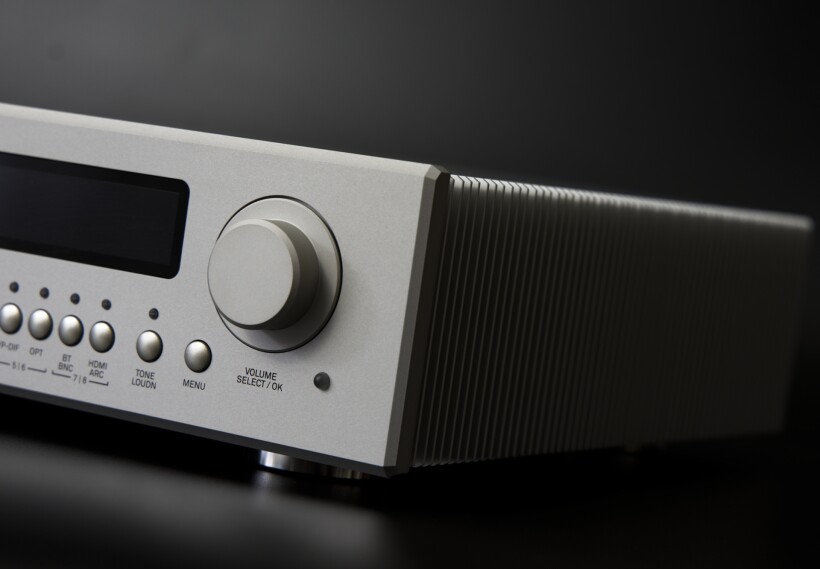
Considering the fact that both of these products hit the market last year (2020), one might think that the company was a bit late to the party, as the market is already quite saturated with hundreds of headphones models. Even the race for the the best cans, headphone amplifiers and complete sets that has been going on for quite a few years has slowed down a bit, or at least that’s how it seems to me. The Germans, however, seemed not to be bothered by that at all. Why, one may ask? Well, because from the very beginning they decided to enter the market with a bang, so to speak, targeting its upper regions, offering top-shelf products for the most demanding music lovers. The strategy is well-thought-through. On the one hand, it is true that developing top products is not easy, on the other hand, the market is not as crowded at the top level as it is at more affordable ones. Besides, having the knowledge, technologies and appropriate technical and human resources handy, the T+A could have afforded such a bold move.
Although the Solitaire P is not under review here, they were among the headphones I used to evaluate the tested amplifier, which gave me an opportunity to get to know their class as well. All it takes is a quick search of the Internet to realize that they have already found a large group of (rather wealthy) fans who apparently share my opinion. The Solitaire P cost a lot, but in my opinion they belong to a small group of the best headphone models money can buy today (excluding extremes such as Sennheiser’s Orpheus or HiFiMan’s Shangri-La, that cost more than a car), which justifies the price. Having such a classy proposition for headphone fans, T+A decision-makers had to ensure that the latter were given the second essential element of any headphone system, i.e. a high-class headphone amplifier, that would allow music lovers to use the full potential of Solitaire P.
In order not to leave anything to chance, engineers of the German company decided to integrate the headphone amplifier with their renown digital-to-analog converter so that the former is fed with top quality signal from the latter. Ultimately they developed a device called T+A HA200, which is not only capable of driving almost any headphones through one of the three headphone outputs (including two balanced ones), but also to accommodate almost any digital or analogue source due to a wide range of digital, but also analog (RCA and XLR inputs) inputs. Before we take a deep dive into T+A HA200’s performance, we should get to know the device and its vast functionality first.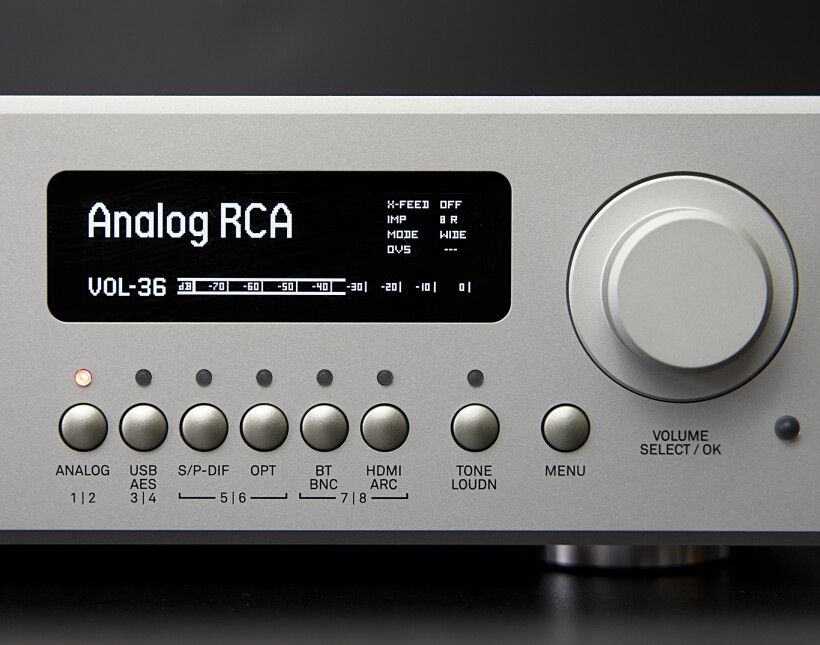
Design & Features
On the outside, the HA200 is an exceptionally good-looking (I know, beauty is a relative thing, but still…), well-made device with quite a modern appeal despite the two „old-school” VU-meters on the front. I am even tempted to say that this is a perfect example of German engineering. I myself am not one of those people for whom the appearance of an audio device is of particular importance, or at least a decisive factor, but still, l will always choose a component that sounds and looks great over one that only sounds great. With all its impressive functionality, I’ll discuss in a moment, the T+A measures (only) 340x100x320mm, weighing about 6 kg, so it is smaller than a standard component. The chassis (available in silver and black) is made of precisely machined and beautifully finished aluminum elements. Obviously it is the front with various, densely packed elements that catches an eye first, but the perfectly made heat sinks on the sides please the eye as well. The latter are recessed into the outline of the housing, so when viewed from the front, they are completely hidden. It is worth mentioning that they are not decorative elements only. They have an important function to perform, as this is a Class A headphone amplifier, and thus it produces a lot of heat that needs to be effectively dissipated.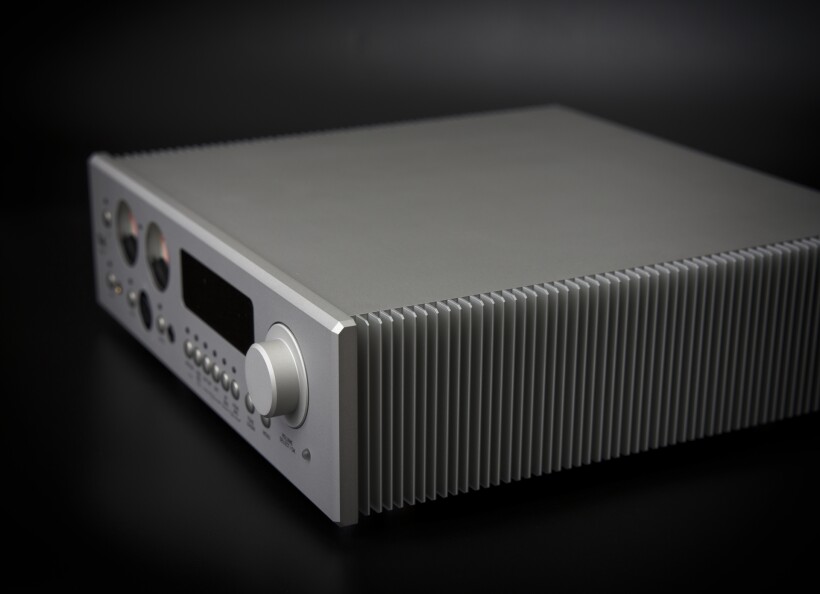
On the front, the second eye-catcher next to the already mentioned two analog VU-meters, showing the input signal level by default (for the right and left channels separately), is the highly legible monochrome display. It presents information regarding a selected input selected and current volume level in the clearest way. It does include much more information though, presented with smaller characters on the right side. It allows user to read information regarding other settings, such as: upsampling, output impedance or cross-feed. The large knob is used to adjust the volume, but it also makes it easier to navigate device’s menu when selecting specific settings. Below there is a “menu” button that gives you access to it, and on its left there is another one that initiates tone control. Next to it you will find six more push-buttons that activate one of the eight available inputs (some buttons have a double function). There are three headphone outputs under the VU-meters – two balanced ones (4-pin XLR and Pentaconn) and an unbalanced one (large jack), accompanied by buttons activating each of them separately. In the upper left corner of the front panel there is an on/off switch and an accompanying power LED indicator.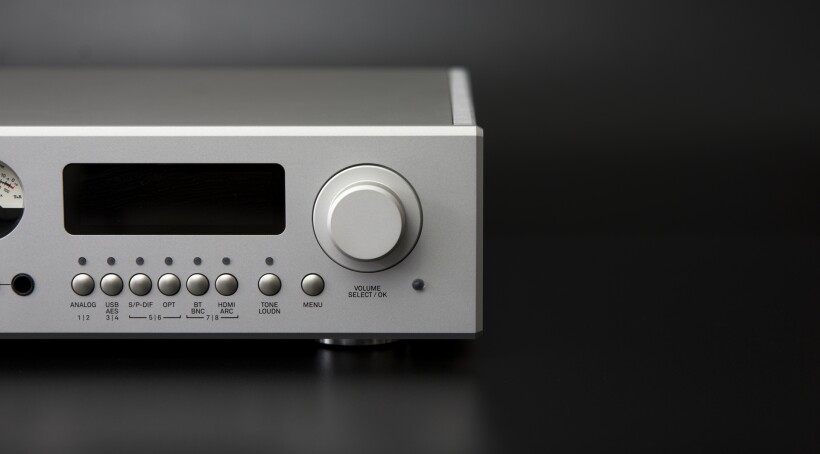
The rear of the device looks equally impressive. The upper left quarter hosts a set of six „traditional” digital inputs. There are two coaxial SPDIFs, two optical Toslinks, one balanced AES/EBU and one BNC. Below are two analog inputs – balanced (XLR) and unbalanced (RCA) ones, which allow you to use external analog sources such as a turntable (via a phono preamplifier, of course), a CD player, tuner, or even an external DAC, if for whatever reason you may prefer one over the in-build converter. In the mid-part, near the top edge, there is a Bluetooth antenna socket, which will allow you to wirelessly connect your smart devices to the HA200 and play music directly from them. Below you will find two USB ports, one of which is the Audio input, the other is called the „system” (i.e. probably for use by the service/manufacturer personel). Next to it, there are a total of four Ethernet sockets, although none of them serves as an audio input – two of them are links to connect the HA200 to other T+A devices, the other two are system connections. There is also a USB socket that can be used to charge portable devices (5V/1A), a power inlet and one more section, unoccupied in the case of the tested unit. The latter can be used to install a HDMI module with two HDMI inputs and an one ARC output, which will allow you to connect, for example, a Blu-ray player or a game console to the HA200, and thanks to the ARC output, you can connect the device to your TV set.
The interior of the device gives an equally good impression of well-thought-out order, one can’t really see any corner or cost cutting, but rather lots of high-quality components. There are four PCM1795 DAC chips in the digital-to-analog converter section that are responsible for processing of the PCM signal. The DSD signal is handled by the T+A’s proprietary solution called True 1-bit converter – the name is self-explanatory. A large part of the interior is occupied by a power supply section with a distinctive pair of twin toroidal transformers (50VA each). The Class A output stage features MOSFET transistors. The volume control is based on precise resistors, and the circuit features Japanese relays with gold-plated contacts.
As I have mentioned already several times, the HA200 is an exceptionally feature-rich device. It is a digital-to-analog converter featuring almost every possible digital input (except LAN, but that’s because a separate streamer is being developed and will join the range in the near future) supporting all major formats and even the highest resolutions. It is also a headphone amplifier offering as many as three different outputs, including two balanced ones and quite a high output. It also allows you to adjust the output impedance to best accommodate each specific headphone model. When buying the T+A set consisting of the HA200 and Solitaire P headphones, you can choose from three headphone cables, which allows you to use any of the available outputs (let me suggest a balanced one, though). Importantly – the minimum impedance of the headphones, when connecting one pair, should be 10Ω. One can connect two pairs at the same time, but then impedance of each headphones must be at least 20 ohms. The HA200 also offers two analog inputs enabling the use of external analog sources, and an optional HDMI module can be purchased separately. The only feature missing, at least from my perspective, is an analog output, which would enable using the HA200 as a preamplifier in a stereo set with speakers. There is a way around it, not the most elegant one, but available, as the manufacturer offers an adapter that can be connected to the XLR headphone output on one end and RCA inputs of a power amplifier on the other.
Additionally, using the menu and manipulators or a neat, metal (!) remote that supports a huge number of functions, we get an access to a number of further options and settings. These are meant to allow us to adjust the sound to individual expectations, preferences or to the music material being played. A cross-feed function is available to change the spatial aspect of the sound presentation and make it less headphone and more speaker like. You can use several types of upsampling (for digital inputs), of which I liked the NOS the most (i.e. … no upsampling), but for rock or other more dynamic music, I changed it often to one of the others. There are standard elements such as tone and balance controls. You can also choose the frequency response range (I chose “wide” and recommend you doing the same) and the loudness setting, which plays some role when listening to the music on low sound levels. To put it briefly – the T+A HA200 headphone amplifier/DAC offers user a lot of control over the sound that ultimately comes from headphones – there are not that many devices that could compete with the reviewed device in this regard. So it was clear to me from the start that it was going to be a very interesting experience.
Sound
For the T+A HA200 test I mainly used three fantastic, top quality headphones. First of all, my own, excellent Audeze LCD3 (paired with a balanced WyWires RED cable terminated with a 4-pin XLR plug). Secondly, the fantastic Final D8000 PRO (with a proprietary unbalanced cable with a large jack) and thirdly, the T+A’s own, sensational Solitaire P. For the latter I had all three cables at my disposal and after a while it was clear the the balanced connections worked best, with the XLR one been a touch better than the Pentaconn, and the large jack being still very good, but a bit behind the other two in terms of sound quality. The source sending the signal directly to the HA200’s USB input via the David Laboga Expression Emerald USB cable (test HERE) was my dedicated music server with Roon. Optionally, I used the same server sending the signal via LAN (via the David Laboga Digital Sound WAVE Sapphire cable – test pending) to the LampizatOr Pacific’s Ethernet input and then with the Hijiri Kiwami RCA analog interconnect to the HA200’s analog input. The third source was my reference J. Sikora Standard Max turntable with the KV12 tonearm and the AirTight PC3 cartridge supported by the ESELab Nibiru phono preamplifier (see HERE) connected to RCA input of the reviewed component.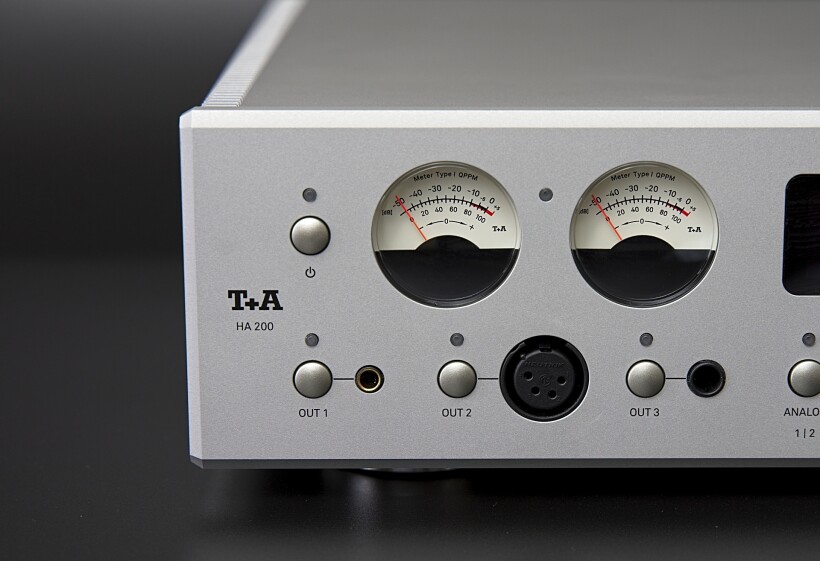
I started my listening sessions with the LCD3 simply because I’ve been using it for several years and I know them best. These are headphones that many people (not me!) consider sounding “dark”. I know from experience with many headphone amplifiers that these cans require a partner capable of driving them properly and when it happens they show their real class and this “dark sound” turns out to be a result of a very high resolution, translating into a richness and saturation of the sound that compared to many other models that are not as rich, as full sounding, may be perceived as ”dark” (while it is the others that sound bit too bright and lean in comparison). And because there are more of the latter, they set the “standard” in a way that other headphones are judged by, but that’s just my opinion, obviously. So the first thing they require is a signal of appropriate high resolution, clarity and transparency. Secondly, an amplifier must be able to drive them properly, which is not easy, to let them fully spread their wings, so to speak. Thirdly, a balanced connection is preferred, therefore, even though I have a theoretically higher class, though unbalanced, cable for them (Entreq), during the test I used a balanced (also very good) RED WyWires one with an XLR termination.
It took me only a few minutes of listening, and I started with the Steve Gadd Band’s “Gadditude”, to state unequivocally that the HA200 does not lack resolution or power to drive LCD3 properly, and on top of that it adds refinement at a level that I had experienced only a few times before, with absolutely top designs. The treble, Steve Gadd’s cymbals, were fantastically differentiated, had proper weight, and each sound was followed by a long, full reverb. With some amplifiers the cymbals can sound even a bit more vibrant, touch brighter and more aggressive, but the version of their sound proposed by the T+A proved that this device is focused primarily on the making listening as enjoyable, pleasant as possible. The HA200 differentiates recordings very well, though, making perfect use of the advantages of the high quality ones, showing the full extent, the richness of the musical and non-musical information they contain. At the same time, however, it makes sure that, in order to make listening experience pleasant, if needed, some excessively bright/aggressive elements of the sound are gently tempered, so to speak. Later, this first impression was confirmed again and again with other recordings and other headphones. I had no doubt from the start that the German device offers a refined, smooth, resolving, but above all natural, musical and truly listener-friendly sound.
On the Gadd’s album the drums and bass not only extended really low, but importantly even at the lowest end I could still hear an excellent control, which is not easy to achieve with the LCD3, thus confirming the class of the tested amplifier. The HA200 delivered not only a very noticeable (obviously in the headphone scale – by definition that’s a different sound than presented by loudspeakers) bass slam, but also an excellent differentiation in terms of both, timbre and dynamics. The midrange, as always with the LCD3, was rich, colorful (not colored!), dense, but also beautifully open and fluid, and it occupied its rightful central place in the presentation. Both frequency extremes complemented it perfectly though, creating a coherent, dynamic, exceptionally natural-sounding whole.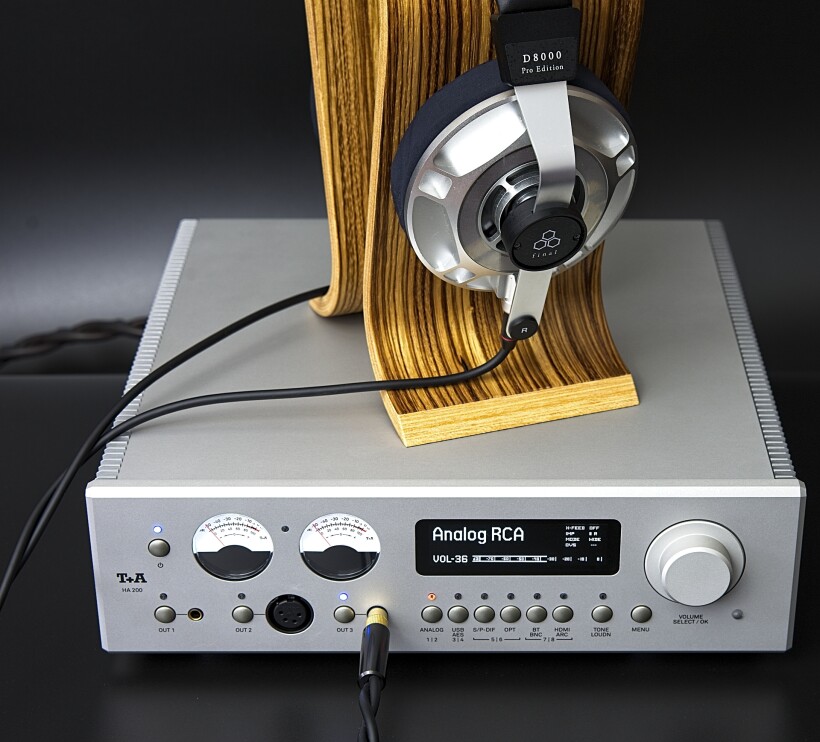
The LCD3 did not sound “dark” at all to my ear with the HA200, but even if one could claim that the sound was somewhat on the darker side of things, this is how most high end or even top high end components sound like. This is due to the density, richness, high resolution of the sound, and not any shortcomings of the presentation. I did not have an opportunity to check it, but I suspect that the, say, HiFiMan HE1000 would sound a bit “brighter” in this combination (which does not mean bright!) adding, as far as I know them, some “sparks” and a bit of „shine” at the top end of the band more effectively. For me, it is a matter of taste, individual preferences, rather than class difference – the performance of the LCD3, especially with such a good amplifier and DAC as the HA200 turned out to be, definitely suited me.
Switching to the Final D8000 PRO (I must note that it was my first encounter of this model – previously I listened only to the “standard” D8000, but I gave myself a lot of time to get to know their sound before using them to asses the T+A) resulted in the same music being presented in a slightly different way. The tonal balance shifted a bit up (which to some extent was, as the test with the LCD3 with the Entreq cable showed, the effect of an unbalanced connection). I wouldn’t call the difference significant, but it was noticeable. There were some more sparks on the cymbals, some more „light” around the high-sounding instruments, and even more air filled the stage. At the same time, the Japanese cans driven by the HA200 did not sound as perfectly weighted as it was the case with my LCD3, and the sound of sticks hitting cymbals was not as powerful, although the immediacy was impressive. It seemed that in this combination a bit more emphasis was put on definition, contour, attack speed, and a bit less on weight and richness of the lower frequencies. Which showed also that the tested device is quite a versatile device, which allows the headphones to decide the final sonic character, the nature of what we hear. In my opinion, that’s how it should always be!
Due to my long acquaintance and very warm feelings for the LCD3, I reluctantly admit it, but I liked the slightly more ethereal, more sparkling highs proposed by the Japanese headphones powered by the HA200 even more than the Audeze version. I would prefer to combine them with the dense, weighted lower part of the Audeze band, thus obtaining my private ideal of headphone sound. Because the bass extension, which was also shown by the next recording by Marcus Miller, was not as deep and weighted as with the LCD3, but compactness, tautness, immediacy, in other words, all the elements resulting from the perfect drive and full control of the headphones by HA200 were impressive. Despite the fact, let me remind you one more time because it is important, that the with the D8000 PRO I had to use an unbalanced connection with the amplifier. I simply did not have a balanced cable for them, and as the tests showed, the latter usually provides better results in these aspects of the sound. I wonder how much of an improvement would a balanced cable still bring to the table…? I bet a lot!
In the same repertoire, the T+A’s own setup with the Solitaire P in terms of treble sounded a bit closer to Audeze, focusing on fantastic weighting and filling in the treble combined with excellent differentiation. Yet, at the same time, this system showed its advantage over American headphones due to the vibrancy, dynamics and energy that was actually a bit more like those presented by the D8000 PRO. They were still a bit “darker” sounding than with the system consisting of the HA200 and Japanese cans, but also a bit brighter than with the LCD3. The lower end, on the other hand, resembled the Finals more – it was tight, as fast as necessary (for a given recording), with a strong attack and long decay. I could feel the power of Marcus Miller’s bass, but it were the quick passages, in which he hit the strings of his guitar strongly and quickly, that sounded most impressive rather than those with the lowest, deepest sounds. On the other hand, in a track from “Jasmine”, Charlie Haden’s bass delivered by the T+A set delighted me with it beautiful, natural timbre and texture, precision of each string pluck and excellent control and definition of the „wood”. Whenever any system does not offer such good control and definition of the lower end of the range, the sound resonating in the large double bass’ box is often a bit dull or boomy, but the HA200 made sure it was exactly as it should have been, with each of the headphones I used for the test.
The comparison with the Final’s D8000PRO showed how precise the HA200 can be. Among these three pairs of headphones, the Japanese ones are the most (which does not mean excessively) analytical, they offer the best insight into the deeper layers of recordings, and allow you to look closely at small details and subtleties. They are also the most selective ones, which allows you to easily focus on the chosen instrument, melodic line, etc. The others can also show the wealth of information, details and subtleties provided by the HA200, but in their cases these are used more as elements or components used to make up the larger, thanks to them richer and fuller, whole. The tested amplifier/DAC effortlessly kept up with the Finals in this respect, providing a well-ordered, highly resolving, clean signal, while ensuring that its analytical abilities, although important, did not become the dominant element of the presentation. It is more a matter of the availability of a huge amount of information, giving the listener the ability to easily reach for selected ones, the precision of presenting them, than the domination of this feature.
To my surprise, it was when listening to the Iron Maiden’s “Seventh son of a seventh son” that it became most obvious, that the HA200 allows headphones it drives to preserve or display their own character. It was a surprise because I heard most clearly listening to music that rarely visits my playlists. Whenever I choose to listen to some „heavier” sounds, I prefer AC/DC, Rush or Aerosmith, not Iron Maiden. In this case, however, listening to this album with the HA200, combined with frequent headphone swaps, showed me in part why I don’t listen to Iron Maiden too often. Simply, neither my Audeze, nor the otherwise excellent D8000 PRO made me want to take w deeper dive into this band’s discography. It did change, however, with the T+A amp+cans set. Although the vocalist’s sibilants were strongly present with it, the whole performance was presented in the cleanest, most coherent, most engaging way because, and that’s the most interesting part, of the fantastic dynamics. The Solitare P driven by the HA200 brought out the most textures from this music, the greatest (which does not mean actually great) depth, making it an interesting, engaging and, of course, energetic spectacle. Good drive, steady pace and rhythm, slightly softened, but still present „metal dirt”, tones of energy – all this made me listen to the whole disc and enjoy it (!), Even though, once again, such music goes, generally speaking, outside my zone comfort.
Summary
The HA200 makes full use of the achievements of T+A engineers in the field of digital-to-analog conversion, and the signal amplification section for the headphones is also of a truly high-end quality. Could this device be even better? In terms of sound performance there is always some room for improvement regardless of how good and how expensive said component already is. The HA200 is already feature-packed and the optional HDMI inputs and output module not included in the reviewed unit expands functionality of this device even further. What else would I like to see in the HA200? An analogue output. Why? Well, because the HA200 is a fantastic D/A converter, definitely good enough to be a source for any even high-end stereo system. So if it were equipped with an output, it could become a heart of two systems – one with headphones and another one with loudspeakers. There is an option with an adapter using the XLR headphone output but it is certainly not optimal in terms of use or aesthetics. I can’t testify to sonic performance because I didn’t have a chance to assess it.
It does not change the fact that the HA200 will be a great partner for most of the top dynamic and planar-magnetic headphones available on the market. It will easily keep up with them in terms of performance serving a highly resolving, dynamic, clean, saturated signal, confidently leading the pace and rhythm, presenting any music in a dynamic, open, fluid way. Judging by the three pairs of headphones I used to assess the HA200, on the one hand it allows the headphones to decide the final character of what reaches the listener’s ears (which can be shaped to some extent due to the number of settings and options featured in the reviewed amplifier/DAC). On the other hand, however, it makes sure that the sound is pleasant to the ear, devoid of harshness, brightness and aggressiveness, but rather fluid and musical, or in a word, allowing one (using some comfortable headphones) to spend long hours listening to the music without any fatigue. The HA200 is a fantastic device for music connoisseurs, and you definitely should listen to it also with the excellent Solitaire P. This is an absolutely outstanding set! It’s expensive, you may say. True, but with these new products the T+A simply targets those looking for the best performance in the most feature-packed and great-looking audio components for whom price is not a deciding factor.
Technical specifications (according to the manufacturer):
Analogue section:
- Frequency response + 0/−3 dB: 0,1 Hz – 200 kHz
- Signal / noise ratio: 110/114 dB
- THD/Intermodulation: < 0,001 %/< 0,001 %
- Channel separation: > 108 dB
- Class A operation up to 700 mA
- Loudness: switchable, adjustable on the headphones efficiency
- Sound control: switchable, channel separated. Bass and treble -6 dB to + 8 dB
- Headphone outputs: 6.3 mm plug, 4.4 mm Pentaconn, XLR-4 pin
- Impedances: 8, 12, 18, 25, 40, 80 Ohms
Digital dection
- PCM: Double-Differential-Quadruple-Converter with four 32-Bit Sigma-Delta D/A converter per channel 705,6 / 768 kSps conversion rate
- DSD: T+A-True-1Bit DSD D/A converter, up to DSD 1024 (49,2 MHz), native bitstream
- Upsampling: T+A signal-processor – synchronous upsampling with four selectable oversampling algorithms. FIR short, FIR long, Bezier/IIR, Bezier, NOS (non-oversampling))
- Analogue filter: Phase-linear Bessel filter 3rd order, switchable with 60 or 120 kHz cut of frequency
General:
- Dimensions (H × W× D): 10 × 32 × 34 cm
- Accessories: Remote control FM8, power cord, USB-cable for charging RC, USB cable 2.0 for DAC, RCA cable
- Weight: 6,5 kg
- Finishes: Alu silver anodized (43), Alu black anodized (42)
Price (when reviewed):
- T+A HA200: 6.600 EUR
Manufacturer: T+A
Polish Distributor: HI-TON
Associated equipment:
- Analogue front end: J.Sikora Standard MAX turntable, J.Sikora KV12 tonearm, AirTight PC-3, phonostages: Grandinote Celio mk IV, ESE Lab Nibiru V 5, Thoeress Phono Enhancer
- Digital source: a passive, custom server with WIN10, Roon, Fidelizer Pro 7.10, JCat USB Femto card with iFi power supply, Hdplex linear power supply for PC, JCAT USB Isolator
- Headphones: T+A Solitaire P, Audeze LCD-3, Final D8000 PRO
- D/A Converter: LampizatOr Pacific +Ideon Audio 3R Master Time (USB signal regenerator)
- Power amplifiers: GrandiNote Shinai, LampizatOr Metamorphosis, Accuphase E380, Circle Labs A200, Lavardin ISx Reference
- Preamplifier: Audia Flight FLS1
- Loudspeakers: GrandiNote MACH4, Ubiq Audio Model ONE Duelund Edition.
- Interconnects: Hijiri Million, Hijiri HCI-20, TelluriumQ Ultra Black, KBL Sound Zodiac XLR, David Laboga Expression Emerald USB, TelluriumQ Silver USB
- Speaker cables: LessLoss Anchorwave
- Power cables: LessLoss DFPC Signature, Gigawatt LC-3
- Power: Gigawatt PF-2 MK2 and Gigawatt PC-3 SE Evo+; a custom power line with Gigawatt LC-Y in-wall cable; Gigawatt G-044 Schuko and Furutech FT-SWS-D (R)
- Racks: Base VI, Rogoz Audio 3RP3/BBS
- Anti-vibration accessories: ROGOZ-AUDIO SMO40 and CPPB16 platforms and ROGOZ AUDIO BW40MKII feet, Franc Accessories Ceramic Disc Slim Feet and Wood Block Platform



